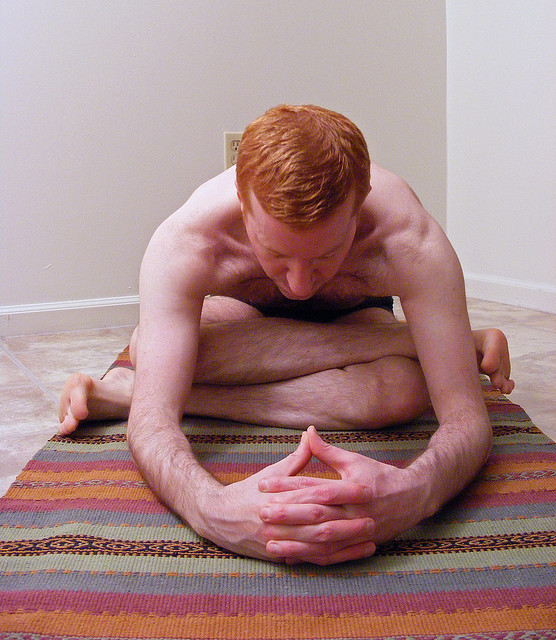
“The cultural obsession with looking for perfection diminishes our ability to see the perfection that is already established in us as live, and abundantly given.” ~ Mark Whitwell
Along with several hundred other people, I attended an unheated class led by Bikram himself, at a Yoga Expo in LA, 12 long years ago.
He stood on a platform, ranting and raving, wearing a tiny loin cloth and a wireless microphone headset. The room was maybe 80 degrees. They couldn’t get the temperature up high enough because it was such a giant space.
I was appalled that there was no final relaxation in Savasana. I was the only person who laid down instead of stampeding out of the room.
All too often, the meditative aspect of yoga falls by the wayside. This means we are doing fancy calisthenics—and maybe even some fancy breathing—and calling it “yoga.”
We need to quit comparing our bodies to others people’s bodies. When we learn to accept and feel grateful for the changes in our physical beings, from side to side, day to day, and moment to moment.
Super active, cardio styles of yoga bolster our Western tendency to go-go-go. Stay busy! Get faster, better, more dynamic. Change the world. Yang yoga thrives, because people want to look good naked. We want to know the drill.
Yin yoga is the remedy for our yang world.
You know the yin/yang symbol, of course. Yin and yang are two sides of the same coin. Yang is masculine, active, solar, energetic, decisive, and associated with the exhale, while yin is feminine, passive, lunar, cool, flowing and associated with the inhale.
Both are strong, just different types of strength.
Yin yoga involves sitting, bending forward, reclining, twisting ever so gently—just being there. Holding poses for several minutes. Letting go of tension, effort and ambition. Allowing the spine to round. Releasing the jaw, the face, shoulders and neck. Allowing gravity pull us down, down, down toward the core of the Earth.
Staying with a pose for so long, not jumping back and executing vinyasas every two minutes, the mind is free to wander. And wander it will. We may experience itchy impatience (how much longer are we going to hold this god-forsaken pigeon?), fiery judgment (my body is not as flexible as it used to be; I can’t believe how much I suck!) and flat-out boredom.
Like seated meditation, yin yoga gives us the opportunity to bask in nothingness. This is excruciatingly difficult at first. Things come up, rapid fire. Items you absolutely must write on your to do list immediately. The perfect name for your second born child, even if you’re unmarried and happy about it. How badly you need a pedicure. Worries about a troubled friend or aging parent.
Folks often confide to me that they can’t meditate because their minds are too active. That’s like saying you’re not flexible, therefore you can’t do yoga. Or you’re not strong, so you can’t lift weights. Start where you are. The goal of meditation is not a perfectly clear mind. In fact, there’s no such thing.
The mind will try anything and everything to get you off the mat, out of the pose, away from the present moment. That’s its job. And our job is to simply observe all the thoughts, memories, sensations and plans with equanimity and a sense of humor.
Savor the silence.
~
Relephant:
Diving Deep with Yin Yoga.
A Grounding Yin Yoga Sequence for Travellers.
~
Author: Michelle Margaret Fajkus
Editor: Katarina Tavčar
Photo: Nicholas A. Tonelli/Flickr
 Share on bsky
Share on bsky





Read 7 comments and reply